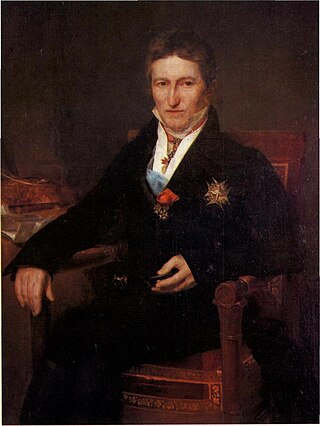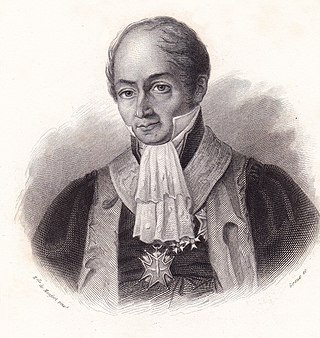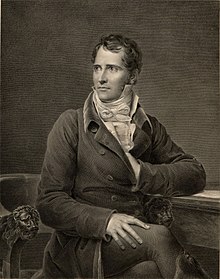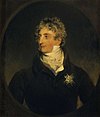
The Second Bourbon Restoration was the period of French history during which the House of Bourbon returned to power after the fall of Napoleon in 1815. The Second Bourbon Restoration lasted until the July Revolution of 26 July 1830. Louis XVIII and Charles X, brothers of the executed King Louis XVI, successively mounted the throne and instituted a conservative government intended to restore the proprieties, if not all the institutions, of the Ancien régime. Exiled supporters of the monarchy returned to France but were unable to reverse most of the changes made by the French Revolution. Exhausted by the Napoleonic Wars, the nation experienced a period of internal and external peace, stable economic prosperity and the preliminaries of industrialization.

Jean-Baptiste Guillaume Joseph Marie Anne Séraphin, 1st Count of Villèle, better known simply as Joseph de Villèle, was a French statesman who served as Prime Minister in the 1820s. He was a leader of the Ultra-royalist faction during the Bourbon Restoration.

François Alexandre Frédéric de La Rochefoucauld, 7th Duke of La Rochefoucauld, 1st Duke of Liancourt, 2nd Duke of Estissac was a French social reformer.
The Ultra-royalists were a French political faction from 1815 to 1830 under the Bourbon Restoration. An Ultra was usually a member of the nobility of high society who strongly supported Roman Catholicism as the state and only legal religion of France, the Bourbon monarchy, traditional hierarchy between classes and census suffrage, while rejecting the political philosophy of popular will and the interests of the bourgeoisie along with their liberal and democratic tendencies.

Armand Emmanuel Sophie Septimanie de Vignerot du Plessis, 5th Duke of Richelieu and Fronsac, was a French statesman during the Bourbon Restoration. He was known by the courtesy title of Count of Chinon until 1788, then Duke of Fronsac until 1791, when he succeeded his father as Duke of Richelieu.

Jean-Baptiste Nompère de Champagny, 1st duc de Cadore was a French admiral and politician.
During the Bourbon Restoration (1814–1830) and the July Monarchy (1830–1848), the Doctrinals were a group of French royalists who hoped to reconcile the monarchy with the French Revolution and power with liberty. Headed by Royer-Collard, these liberal royalists were in favor of a constitutional monarchy, but with a heavily restricted census suffrage—Louis XVIII, who had been restored to the throne, had granted a Charter to the French with a Chamber of Peers and a Chamber of Deputies elected under tight electoral laws. The Doctrinaires were a centrist, as well as a conservative-liberal group, but at that time, liberal was considered to be the mainstream political left, so the group was considered a centre-left group.

The Chambre introuvable was the first Chamber of Deputies elected after the Second Bourbon Restoration in 1815. It was dominated by Ultra-royalists who completely refused to accept the results of the French Revolution. The name was coined by King Louis XVIII, referring to the impossibility of cooperating with the chamber.
Duke of Decazes, also called Duke Decazes, is a title of French nobility that was granted in 1820 to Élie Decazes, a French statesman who served as Prime Minister of France from November 19, 1819 to February 20, 1820. He had already been made a French count in 1816. Separately, he was given the hereditary Danish title of Duke of Glücksbierg upon his second marriage in 1818, which title was recognized in France in 1822.
Jean Élie Octave Louis Sévère Amanien Decazes de Glücksbierg, 3rd Duc Decazes and 3rd Duke of Glücksbierg, was a French aristocrat and sportsman.

Louis Jean Victor Sévère Decazes de Glücksbierg, 4th Duc Decazes and 4th Hertig af Glücksbierg, was a French businessman and Thoroughbred racehorse owner and breeder.

Louis-Charles-Élie-Amanien Decazes de Glücksbierg, 2nd Duke Decazes and 2nd Duke of Glücksbierg, was a French diplomat and statesman.
Events from the year 1820 in France.
Events from the year 1819 in France.

The First ministry of Armand-Emmanuel du Plessis de Richelieu was formed on 26 September 1815 after the dismissal of the Ministry of Charles-Maurice de Talleyrand-Périgord by King Louis XVIII of France. It was dissolved on 29 December 1818 and replaced by the Ministry of Jean-Joseph Dessolles.

The Ministry of Jean-Joseph Dessolles was formed on 29 December 1818 after the dismissal of the First ministry of Armand-Emmanuel du Plessis de Richelieu by King Louis XVIII of France. It was dissolved on 19 November 1819 and replaced by the Ministry of Élie Decazes.

The Ministry of Élie Decazes was formed on 19 November 1819 after the dismissal of the Ministry of Jean-Joseph Dessolles by King Louis XVIII of France. It was dissolved on 17 February 1820 and replaced on 20 February 1820 by the Second ministry of Armand-Emmanuel du Plessis de Richelieu.

Pierre François Hercule, comte de Serre was a French soldier, lawyer and politician. He was a deputy from 1815 to 1824, and was Minister of Justice in three successive cabinets from 1818 to 1821. He sat on the center-right, but had liberal views on press freedom, direct elections and the use of juries.

The Exposition des produits de l'industrie française was a public event organized in Paris, France, from 1798 to 1849. The purpose was "to offer a panorama of the productions of the various branches of industry with a view to emulation".
The Liberals was a short lived French liberal political party which was active in several elections before being absorbed into the Doctrinaires, a fellow constitutional monarchy party. Several members of the Liberals eventually went on to serve in the Movement Party and even later in the Orléanist parties. The precedent set by the party would help form modern French classical liberalism, something used in the modern centre-right Republicans party.



















